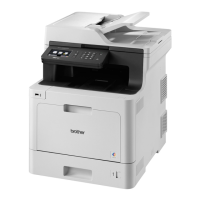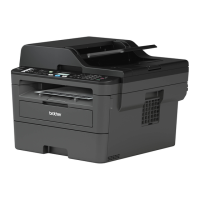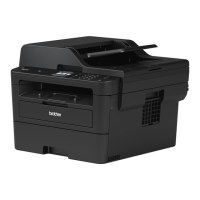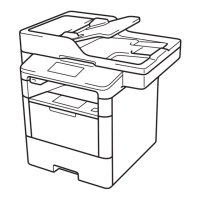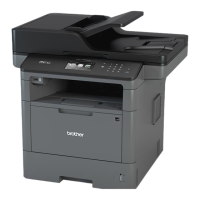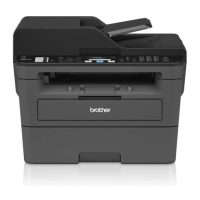





Do you have a question about the Brother MFC-L8600CDW and is the answer not in the manual?
Information on how to access Brother support resources for Macintosh users.
Explains how to operate the touchscreen by swiping and pressing options for navigation.
Guides on how to include frequently used copy settings as shortcuts for quick access.
Guides on how to edit the names of existing shortcuts for better organization.
Detailed steps for loading paper into the standard and optional lower trays.
Details on loading paper into the MP tray, including specific paper types and quantities.
Basic instructions for loading documents for faxing, copying, and scanning.
Detailed steps for loading documents into the Automatic Document Feeder.
Instructions for using the scanner glass for fax, copy, or scan operations, one page at a time.
Step-by-step guide on sending faxes, including document loading and preview options.
Explains how to choose the appropriate receive mode based on line services and external devices.
Provides a flowchart to help select the correct receive mode (Fax, Manual, Fax/Tel, External TAD).
Instructions for using the PC-FAX feature for sending and receiving faxes via a computer.
Steps to set up PC-FAX Receive for storing received faxes on a computer.
Guide on sending documents from a computer as PC-FAX, including application steps.
Discusses potential conflicts with services like Voice Mail and how Distinctive Ring can resolve them.
Explains the Distinctive Ring feature for receiving fax and voice calls on separate numbers on one line.
Details the FaxAbility service for additional numbers and distinctive ring patterns.
How to utilize Distinctive Ringing for multiple telephone numbers on a single line.
Illustrates how to connect an external Telephone Answering Device (TAD) to the machine.
Instructions for connecting separate telephones directly to the machine.
How to operate the machine remotely using activation codes from external or extension phones.
Explains how to use Remote Activation and Deactivation codes for machine operation.
Steps to change the preset Remote Activation and Deactivation codes for improved access.
Explains different methods for dialling numbers, including manual dialling and address book use.
Guides on setting up the Address Book and Groups for broadcasting faxes.
Step-by-step instructions for saving contact information with names and numbers.
Basic steps for performing copying operations, including document loading and starting the copy.
Steps to create a PRN file from an application for direct printing via USB.
Steps for printing documents from a computer, including installing the printer driver and setting properties.
Prerequisites for scanning, including installing scanner drivers and configuring network settings.
Information on replacing consumables like toner, drum, belt, and waste toner box when indicated.
Steps for cleaning the exterior surfaces and touchscreen of the machine.
Steps to adjust colour density for stable print quality and accurate colour reproduction.
Initial checks and steps to identify the cause of machine issues before proceeding with troubleshooting.
Covers difficulties related to software installation and network connectivity for the machine.
Addresses issues when documents are not inserted or fed correctly into the ADF.
Error message for paper jams occurring inside the machine.
Indicates the machine is out of paper or paper is not loaded correctly in the tray.
Error message when a toner cartridge is not installed correctly or is empty.
Indicates toner cartridges are not installed correctly or are low.
Steps to transfer faxes to another fax machine or computer when errors occur.
Instructions for transferring stored faxes from the machine's memory to a computer.
Steps to remove paper jams from the top of the Automatic Document Feeder.
Procedure for removing paper jams located under the document cover.
Instructions for clearing paper jams specifically from the multi-purpose tray.
Troubleshooting steps for common printing issues like no printout or unexpected output.
Solutions for issues related to paper feeding, including jams and incorrect loading.
Steps to resolve issues related to telephone line connectivity and dial tone problems.
Solutions for when the machine fails to receive faxes, checking modes and line connections.
Common issues encountered when sending faxes and their solutions.
Addresses issues where the machine misinterprets voice calls as fax tones or has problems with custom line features.
Troubleshooting steps for problems encountered during copying operations.
Troubleshooting tips for errors like TWAIN/WIA issues, OCR problems, and network scanning failures.
Steps for resolving issues with Brother software installation or printing, particularly on Windows.
Guidance on troubleshooting network printing, scanning, and PC-FAX Receive features.
Troubleshooting steps for power-related issues, including safety mechanisms and power connections.
Solutions for poor fixing, curled/wavy paper, and paper feeding issues.
Guidance on preventing creases when printing envelopes.
Information on various reset functions available for the machine's settings.
Settings related to network configuration, including Wired LAN and WLAN.
Covers basic setup options including Tray Setting, Paper Type, and Paper Size.
Options for editing shortcut names and deleting existing shortcuts.
Settings for receiving faxes, including Receive Mode, Ring Delay, and Fax Detect.
Choosing the receive mode that best suits your needs.
Receive fax messages automatically when you answer a call and hear fax tones.
Settings for PC Fax Receive, Memory Receive, and Fax Rx Stamp.
Set the machine to send faxes to your computer.
Adjust colour density and restore colour calibration to factory settings.
Choose whether to carry out colour calibration and registration automatically.
Settings for TCP/IP configuration, including BOOT Method and IP Address.
Settings for DNS Server, APIPA, IPv6, Ethernet mode, and Wired Status.
Settings for WLAN, including TCP/IP, APIPA, IPv6, and WLAN Assistant.
WLAN Status, Signal, SSID, Comm. Mode, MAC Address, Set to Default, WLAN Enable.
Manual configuration, Group Owner settings, Device Information, and IP Address for Wi-Fi Direct.
Settings for Internet Fax Job, Size Limit, Notification, and Relay settings.
DNS Server, APIPA, IPv6 configuration for network connectivity.
DNS Server, APIPA, IPv6 settings for wireless network configuration.
Settings for sending and receiving emails via SMTP, POP3/IMAP4 servers.
Configure SMTP server details and POP3/IMAP4 settings for email.
Convert scanned documents to editable text files.
Scan documents into computer files.
Scan pictures into graphics applications.
Scan documents directly to a USB flash drive.
Scan documents into your email application.
Scan documents to an email server, configuring address and server settings.
Send scanned data to a FTP or SFTP server.
Send scanned data to a network server or the Internet.
Adjust colour density or reset calibration to factory settings.
Choose desired settings from preset items for Copy and Fax.
Store fax numbers, adjust scan area, and scan documents to computer or USB.
Scan to Network, FTP/SFTP, Web services, or Apps.
Scan documents to File, OCR, Image, USB, or E-mail.
Steps to maintain stable print quality by adjusting toner density and colour balance.
| Type | all in one |
|---|---|
| Color | white |
| Tray Capacity | 300 |
| Automatic Document Feeder Capacity | 35 sheets |
| Paper Size | 8.5" x 14" |
| Paper Handling | up to 300 sheets |
| Color Print Speed | 30 pages per minute |
| Mono Print Speed | 30 pages per minute |
| Print Resolution Color | up to 2400 x 600 |
| Maximum Number of Pages Per Month | up to 40, 000 |
| Scanner Type | flatbed |
| Scan Resolution | up to 2400 x 1200 |
| Cartridges | tn331bk, tn336bk, tn331y, tn336y, tn331m, tn336m, tn331c, tn336c, dr331cl |
| Number Of Cartridges | 4 |
| Internal Memory | yes |
| Network | wired, wireless |
| Connectivity | usb, google cloud print |
| OS Compatibility | windows, mac os, linux |
| Mobile Devices Connection | yes |
| Height | 16.1 inches |
|---|---|
| Width | 19.8 inches |
| Net Weight | 63.5 pounds |


